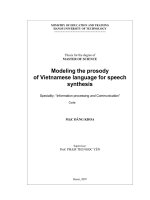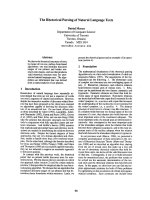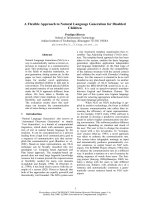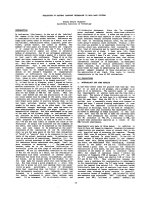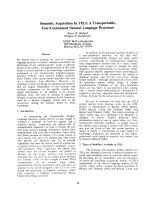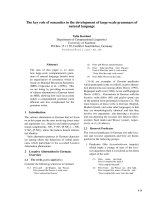PROCEEDINGS OF EMNLP 2020 A PREDICATE-FUNCTION-ARGUMENT ANNOTATION OF NATURAL LANGUAGE FOR OPEN-DOMAIN INFORMATION EXPRESSION
Bạn đang xem bản rút gọn của tài liệu. Xem và tải ngay bản đầy đủ của tài liệu tại đây (1022.17 KB, 11 trang )
A Predicate-Function-Argument Annotation of Natural Language for
Open-Domain Information eXpression
Mingming Sun, Wenyue Hua, Zoey Liu, Kangjie Zheng, Xin Wang, Ping Li
Cognitive Computing Lab
Baidu Research
No.10 Xibeiwang East Road, Beijing 100193, China
10900 NE 8th St. Bellevue, Washington 98004, USA
{sunmingming01, wangxin60, liping11}@baidu.com
{norahua1996, zoeyliu0108, kangjie.zheng}@gmail.com
Abstract properties. Sun et al. (2018a; 2018b) can extract
four types of facts: verbal, prepositional, nominal,
Existing OIE (Open Information Extraction) and conceptional. OLLIE (Mausam et al., 2012)
algorithms are independent of each other such and ClauseIE (Corro and Gemulla, 2013) extract
that there exist lots of redundant works; the relations between clauses. In addition to extracting
featured strategies are not reusable and not the fact tuples, NestIE (Bhutani et al., 2016) and
adaptive to new tasks. This paper proposes a StuffIE (Prasojo et al., 2018) extract nested facts.
new pipeline to build OIE systems, where an Furthermore, MinIE (Gashteovski et al., 2017) add
Open-domain Information eXpression (OIX) factuality annotations to the facts.
task is proposed to provide a platform for all
OIE strategies. The OIX is an OIE friendly Currently, existing OIE systems were typically
expression of a sentence without information developed from scratch, generally independent
loss. The generation procedure of OIX con- from each other. Each of them has their own con-
tains shared works of OIE algorithms so that cerned problem and builds its own pipeline from
OIE strategies can be developed on the plat- a sentence to the final set of facts (See Figure 1a).
form of OIX as inference operations focus- Generally, each OIE system is a complex composi-
ing on more critical problems. Based on the tion of several extraction strategies (for rule-based
same platform of OIX, the OIE strategies are systems) or data labeling strategies (for end-to-end
reusable, and people can select a set of strate- supervised learning). It is rather straightforward
gies to assemble their algorithm for a spe- for specific problems. However, this practice has
cific task so that the adaptability may be sig- several major drawbacks outlined as follows:
nificantly increased. This paper focuses on
the task of OIX and propose a solution – • Redundant works. Some common works are
Open Information Annotation (OIA). OIA is implemented again and again in different ways
a predicate-function-argument annotation for in each OIE system, such as converting simple
sentences. We label a data set of sentence- sentences with clear subj and obj dependencies
OIA pairs and propose a dependency-based into a predicate-argument structure.
rule system to generate OIA annotations from
sentences. The evaluation results reveal that • Strategies are not reusable. During the years
learning the OIA from a sentence is a chal- of OIE practice, several sub-problems are be-
lenge owing to the complexity of natural lan- lieved valuable, e.g., nested structure identifica-
guage sentences, and it is worthy of attracting tion (Bhutani et al., 2016), informative predi-
more attention from the research community. cate construction (Gashteovski et al., 2017), at-
tribute annotation (Corro and Gemulla, 2013;
1 Introduction Gashteovski et al., 2017), etc. Each sub-problem
is worthy of being standardized and continually
In the past decades, various OIE (Open Informa- studied given a well defined objective and data
tion Extraction) systems (Banko et al., 2007; Yates sets so that the performance could be fairly eval-
et al., 2007; Wu and Weld, 2010; Etzioni et al., uated and the progress can be continually made.
2011; Fader et al., 2011; Mausam et al., 2012) However, it is not easy in the current methodol-
have been developed to extract various types of ogy, since each pipeline’s strategies are closely
facts. Earlier OIE systems extract verbal relations bonded to own implementation.
between entities, while more recent systems en-
large the types of relations. For example, Rel-
NOUN (Pal and Mausam, 2016) extract nominal
2140
Proceedings of the 2020 Conference on Empirical Methods in Natural Language Processing, pages 2140–2150,
November 16–20, 2020. c 2020 Association for Computational Linguistics
(a) Traditional OIE systems. (b) OIX based OIE system.
Figure 1: Methodologies to construct OIE systems
• Unable to adapt. Because of the above two fac- one is interested in a part of information) compete
tors, there is no platform to implement the shared with each other for words. This competition may
requirement to provide unified data set, and the result in more robust expressions than those who
strategies are not reusable. Furthermore, each only extract part of the information. This paper
OIE system extracts the interested facts in the de- focuses on investigating the OIX task requirements
sired form at the time of development and omits and finding a solution for this task.
the uninterested facts. Consequently, they are
not adaptable to new requirements. If the inter- In Section 2, we discuss the principle of design
ests or the requested form of facts change, one solution for OIX and propose a solution – the Open
may need to write an entire new OIE pipeline. Information Annotation (OIA) – to fulfill those
principles. The OIA of a sentence is a single-rooted
As the OIE task has attracted more and more in- directed-acyclic graph (DAG) with nodes repre-
terest (Christensen et al., 2013, 2014; Fader et al., senting phrases and edges connecting the predicate
2014; Mausam, 2016; Stanovsky et al., 2015; Khot nodes to their argument nodes. We describe the
et al., 2017), the above mentioned drawbacks have detailed annotation strategies of OIA in Section 3.
delayed the progress of OIE techniques. The key to Based on the OIA, several featured strategies from
conquering those obstacles is to provide a shared existing OIE algorithms can be ported to work on
platform for all OIE algorithms, which express all the OIA. Section 4 discusses the possible imple-
the information in sentences in the form of OIE mentation of those strategies on the OIA. We la-
facts (that is, predicate-arguments tuples) without bel a data set of OIA graphs, build a rule-based
losing information. OIE strategies can focus on in- pipeline for automatically generating OIA graphs
ferring new facts from existing ones without know- from sentences, and evaluate the pipeline’s per-
ing the existence of the sentence. With this plat- formance on the labeled data set. All these work
form, the strategies are reusable and can be fairly are stated in Section 5. We discuss the connec-
compared. When confronting a specific task, one tion from OIA to Universal Dependency, Abstract
can select a set of strategies or develop new strate- Meaning Representation (Banarescu et al., 2013),
gies and run the strategies on the platform to build and SAOKE (Sun et al., 2018b) in Section 6. We
a new OIE pipeline. In this manner, the adaptability conclude the paper in Section 7.
is much improved. This new methodology of OIE
is shown in Figure 1b. 2 Open Information eXpression
We name the task of implementing such a 2.1 Design Principles of the Expression Form
platform as Open Information eXpression (OIX),
where eXpression is used to distinguish from Ex- We consider the following factors in designing the
traction to emphasize that it focuses on express- expression form for the OIX task:
ing all the information in the sentence rather than
extracting the interested part of the information. • Information Lossless As the OIX task is to pro-
This methodology potentially results in a multi- vide a platform for following OIE strategies, the
task learning scenario where many agents (each loss of any information is unacceptable. A sim-
ple constraint can guarantee this: any word in the
2141
sentence must appear in the target form of OIX. • Constants: express entities, such as “the solar
system”, “the Baidu company”; or status of en-
• Validity It must implement the information tities/events/relationships, such as “expensive”,
structure of OIE tasks, that is, the predicate- “hardly”.
argument structure. It builds a boundary for
the OIE pipeline: after the OIX task, followed • Functions: f (arg1, · · · , argn) → {e}, express
strategies all work on open-domain facts, with- query of entities or delegation of entities, such
out knowing the original sentences. as “the CEO of X”, “when Y”, where X and Y
denote the arguments of the functions;
• Capacity The form should be able to express all
kinds of information involved in the sentences, • Predicates: p(arg1, · · · , argn) → {0, 1}, ex-
including 1) relation between entities; 2) the press factual relationships and logical connec-
nested facts, that is, fact as an argument of an- tions among entities, predicates, and functions,
other fact; 3) the relationships between facts, in- such as “X buy Y”, “X says Y ”, “Y, because Z”.
cluding the logical connections such as “if-else”
and discourse relations such as “because”, “al- where argi could be a constant, predicate or func-
though”; 4) information in the natural language tion, and {e} is some unknown set of entities re-
other than declarative sentences, such as ques- turned by the function. With these components,
tions that ask to return one or a list of possible the constants and the instantiated functions become
answers (Karttunen, 1977). terms, the instantiated factual predicates become
atom formulas, the instantiated logical predicates
• Atomicity Since the form is a common expres- become general formulas, and finally, a sentence
sion of facts to serve different OIE strategies, we can be expressed as a formula. Through this kind of
have no bias in the form of predicate and per- expression, the gap between the language and the
form atomic expression so that followed strate- knowledge is narrowed. We propose Open Infor-
gies can assemble them according to their prefer- mation Annotation to implement this methodology.
ence. For example (Gashteovski et al., 2017), for
the sentence “Faust made a deal with the Devil”, 2.3 Open Information Annotation
ClausIE produces (Faust, made, a deal with the
Devil), while the MinIE extracts (Faust, made Open Information Annotation (OIA) annotation
a deal with, the Devil). Instead, we would like of a sentence is a single-rooted directed-acyclic
a nested structure ((Faust, made, a deal), with, dependency graph (DAG), where nodes are pred-
Devil) so that followed strategies can assemble icates/functions/arguments and edges connect the
the predicate according to the favor of either predicates or functions to their arguments. OIA
ClauseIE or MinIE. Notice that the atomicity minimizes the information loss by requiring all the
does not means it is in word-level. We still need words (except the punctuation) in source sentences
a phrase-level expression of facts, following the to appear in the graph. It is single-rooted, which
traditional OIE system’s preference for simple meets the sentence’s hierarchical semantic struc-
phrase (detailed in later sections). ture, and is for better visualization, understanding,
and annotation. Figure 2 gives two sample sen-
2.2 Information in Natural Languages tences and their corresponding OIA annotations for
intuitive understanding. We give a formal descrip-
Natural languages talk about entities, the fac- tion of the OIA graph as follows:
tual/logical relationship among them, and describe
the status/attributes of them. When talking about Nodes. The OIA takes the simple phrases as the
entities, the human may talk about some explicit basic information units and build nodes based on
entity or refer a delegate of some unknown enti- these simple phrases. By simple phrase, we mean
ties. When talking about relationships, the rela- a fixed expression, or a phrase with a headword
tionship may be among entities and can be among together with its auxiliary, determiner dependents,
entities and relationships; that is, the relationship or adjacent ADJ/ADV modifiers. There are three
can be nested. So, from the logical view, we need types of nodes: constant, predicate, and function:
the following components to express the informa-
tion in languages: • Constant Nodes: simple nominal phrases, repre-
senting entities in a knowledge base, or simple
description phrases, representing a description
2142
reported
pred.arg.1 pred.arg.2 Parataxis
Reuters issued pred.arg.1 pred.arg.2
pred.arg.2 pred.arg.1 drafted not sure pred.arg.2 if
a Declaration Sunni clerics pred.arg.1 pred.arg.2 as:pred.arg.1 func.arg.1
as:pred.arg.1 mod as:pred.arg.1 I the Into TVA Option as this anything
by {1} , {2} , and {3} in pred.arg.2 as:pred.arg.1
a series of calls close to pred.arg.2 what
pred.arg.2 pred.arg.1 pred.arg.2 pred.arg.3 pred.arg.2
the people of Fallujah condemning announcing calling the town as:pred.arg.1 as:pred.arg.2
pred.arg.2 pred.arg.2 as:pred.arg.1 tied to had
the deaths of pred.arg.2 pred.arg.1 as:pred.arg.1
the security guards
three days of mourning for
and police
the MOPA delivery term and quantity you all in
pred.arg.2 pred.arg.2
a general strike today mind
(a) Case I – Reuters reported “Sunni clerics in the town is- (b) Case II – I drafted the Into TVA Option as a series of calls
sued a ’Declaration by the people of Fallujah’ condemning tied to the MOPA delivery term and quantity - not sure if this
the deaths of the security guards and police, announcing anything close to what you all had in mind.
three days of mourning, and calling for a general strike
today.”
Figure 2: Two example cases of Open Information Annotations
for an event. They are visualized as the ellipse Function Meaning
shapes; Whether whether-or-not function
• Function Nodes: the question phrases (what, 2-ary Predicate Meaning
where) since they are desired to return a set of Modification modification
entities in a knowledge base, or the “of” phrase Reference reference
that delegates an unknown entity. They are visu- Discourse discourse element
alized as the house shapes; Vocative the dialogue participant
Appos apposition
• Predicate Nodes: predicate phrases, including Reparandum speech repair
the simple verbal phrase, simple prepositional
phrase, simple conjunction phrases, simple mod- n-ary Predicate Meaning
ification phrases, etc. They are visualized as the Parataxis parataxis of args
box shapes; List args are elements of a list
The principles of OIX require that each word (ex- Table 1: Predefined Functions and Predicates, where
cept punctuation) in the sentences must belong to for 2-ary predicates, their meanings are “arg1 has a
one and only one of the nodes. However, there is {Meaning} arg2”.
some information hidden in natural language that
is not expressed by words. To honestly express func.arg.{n} for functions, where n is the index
the information, we introduce predefined functions of the argument.
and predicates, as shown in Table 1. Many prede-
fined predicates are borrowed from the Universal When a term is modified by a relative clause,
Dependency (Nivre et al., 2020). the term is acting as an argument of the predicate
expressed by the relative clause, but the predicate is
Edges. Edges in OIA are connecting each predi- used to modify the term. To express such relation,
cate node or function node to its argument, which we reverse the edge and add a prefix as: to the argu-
can be any constant node, predicate node or func- ment edge, such as as:pred.arg.1 or as:func.arg.2.
tion node. There are only two basic types of con-
necting edges: pred.arg.{n} for predicates and For those predefined predicates with two argu-
ments, to reduce the graph’s complexity, we al-
2143
Edge Meaning of A modifies B. The “today” in Figure 3a is an
example.
pred.arg.i predicate to its i-th arg
function to its i-th arg Modification by Preposition. For preposition
p −−−−−−→ argi i-th arg to its predi- phrases such as “A in B” or “A for B”, we take the
cate/function prepositions as the predicates and A, B as the ar-
f unc.arg.i P(arg1, arg2) guments. If A is an argument of another predicate,
is P of (arg1, arg2) to preserve the single-root property, we reverse the
f −−−−−−→ argi edge from the preposition to A and add a as: pre-
fix to the label, that is, a new edge from A to the
as:+ preposition with the label as:pred.arg.1. Figure 3e
is such an example.
argi −−−→ p/f
Modification by Relative clause. When the rel-
P ative clause B modifies an argument a of some
other predicate/function, that is, B itself conveys a
arg1 −→ arg2 predicate/function with argument a, we reverse the
related edge in B and add the as: prefix as we do for
as:P “Modification” by Preposition. Figure 3f illustrates
this case. If B does not involve a as argument but
arg1 −−−→ arg2 an argument b referencing a, like “which”, “who”,
we do the same thing to b, and add an edge from a
Table 2: Edges in OIA. “as:+” means add prefix “as:” to b with label ref.
to the previous listed predicates, and P denotes any pre-
defined predicate with two arguments. 3.3 Cross-Fact Relations
low the use of an edge connecting two arguments Cross-sentential Connectives. Sentential connec-
with the label of that predicates (lowercased) to tives are ignored in many OIE systems, but they are
express the relationship (just as the UD annotation). the “first-class citizen” in our scheme. Sentential
That is, the predicate Appos(arg1, arg2) would connectives such as “therefore”, “so”, “if” and “be-
cause” can represent logical and temporal relations
appos between sentences. We treat them as predicates
and facts/propositions as arguments. An example
be expressed by an edge arg1 −−−→ arg2 in the is shown in Figure 3c.
OIA graph. The as: prefix applies these shortcut
edges too, expressing the meaning of “arg1 is the Conjunction/Disjunction. The conjunction and
{Meaning} of arg2”. We also give abbreviated disjunction are expressed by “and” and “or” among
names for most frequently used edges: mod for a list of parallel components. OIA annotation adds
modification, and ref for reference. a connecting predicate node delegating the compo-
nents such as “and” for two components and “{1}
3 Information Expression Using OIA and {2} or {3}” for three components, and then
link to the arguments with pred.arg.{n}. This is
In this section, we show how to express information illustrated by Figure 3c. More complex situations
involved in various language phenomenons with like Figure 3e are detailed in the online document.
our OIA. We can only brief the basic framework in
the limited content of this paper. More details can Adverbial Clause. We first build the OIA sub-
be found on the online website for OIX 1. graph for the adverbial clause, and then connect
the modified predicate to the root of the sub-graph
3.1 Events with edge mod.
Eventive facts (Davidson and Harman, 2012; 3.4 Questions and Wh-Clauses
Kratzer and Heim, 1998) are facts about entities’
actions or status, which is generally expressed by We treat question phrases and wh-phrases as func-
the subj, obj and *comp dependencies. In OIA, the tions (Hamblin, 1976; Groenendijk and Stokhof,
pred.arg.1 always points to the subject of the event, 1984; Groenendijk and Roelofsen, 2009) and as
and pred.arg.2 to pred.arg.N refer to the (multi- the root of the OIA graph/sub-graph for sen-
ple) objects. A simple example is illustrated by
Figure 3a. Events themselves can be arguments of
predicates as well, as illustrated by Figure 3d.
3.2 Modification
Adjective/Adverbial Modification. Simple modi-
fiers for nouns, verbs, and prepositions are directly
merged into the corresponding phrase. For a com-
plex or remote modifier, we use the predicate “Mod-
ification” with two arguments B and A (or an edge
from B to A with label mod) to express the relation
1 />Open-Information-eXpression/
2144
because
pred.arg.2 pred.arg.1
like and
Whether pred.arg.1 pred.arg.2 pred.arg.1 pred.arg.2
func.arg.1
lent I red is passionate (be) optimistic
know
pred.arg.1 pred.arg.2 pred.arg.3 mod ref pred.arg.1 pred.arg.1
today
pred.arg.1 pred.arg.2
it
She me a book you Bob
(a) She lent me a book today. (b) Do you know Bob? (c) I like red because it is passionate and opti-
mistic.
shall not perish
pred.arg.1 as:pred.arg.1
The goverment from borrow
as:pred.arg.1 as:pred.arg.1 as:pred.arg.1 pred.arg.2 pred.arg.1 pred.arg.2
heard
of by for the earth He the book
pred.arg.1 pred.arg.2 as:pred.arg.2
as:pred.arg.1 as:pred.arg.2 as:pred.arg.3
She is helpful recommended
pred.arg.2 {1} , {2} , {3} pred.arg.2 pred.arg.2
pred.arg.1 pred.arg.1
the book the people the people the people she
(d) She heard the book is (e) The government of the people, by the people, for the people, (f) He borrow the book she rec-
helpful shall not perish from the earth. ommended.
Figure 3: Illustration of Information Expression in Open FPA Graph
tence/clauses. If the phrase (“what”, “who”, etc.) reversed as as:ref. Figure 3c shows the annota-
is an argument of the head predicate of the sen- tion for reference.
tence/clause , the connecting edge is reversed and
the as: prefix is added to the label; otherwise 4 Inference Operations on OIA Graph
(“when”, “where”, etc.), we connect the phrase
to the head predicate of the sentence/clause with After the OIA graph is constructed, inference oper-
the label func.arg.1. For polarity questions such ations can be applied to generate a new graph. In
as “Do you know Bob?”, we introduce a prede- this way, strategies from existing OIE algorithms
fined function “Whether” (see Table 1) to avoid the can be ported to the OIA pipeline. We describe
confusion caused by taking “Do” as the function several possible operations as follows:
phrase. See Figure 2b and Figure 3b.
Constant Merging and Expansion. Noun phrases
3.5 Reference with conjunction/dis-conjunction and preposition
involved (such as “the deaths of the security guards
In natural language sentences, words like “it, that, and police”) may correspond to many nodes in the
which” refer to an entity mentioned earlier. We default OIA graph, which raise the costs of reading
express this knowledge by adding an edge ref from and annotation of the OIA graph. We can merge
the entity to the reference word. Again, if this those nodes as one constant node to reduce the cost
edge violates the single-root rule, the edge will be and expand it back when necessary. Figure 2 shows
the merged versions of the OIA graphs.
2145
Nested Facts. Nested fact extraction is a feature Dependency Parser. Among various types of depen-
of NestIE, which is naturally supported by the dencies, we choose the Universal Dependency be-
OIA graph. cause 1) UD is designed cross-linguistically, which
makes our pipeline potentially possible to port to
Idiom Discovery. Idioms like “in order to”, “as languages other than English. 2) UD is one of
soon ... as”, “be proud of” have specific meanings the biggest data sets for dependency grammar. In
and should be taken as one predicate. One can ap- this paper, we adopt the UD 2.0 standard as the
ply graph pattern mining on a set of OIA graphs target form of UD graphs and employed the neu-
and learn the pattern for idioms, or directly use ral network-based StanfordNLP toolkit 2 (Qi et al.,
the patterns discovered by previous OIE algorithms 2018) to generate the Universal Dependency graphs
such as OLLIE or ClauseIE. Once an idiom is dis- for sentences.
covered and matched, we merge the relevant nodes
to form one single predicate. Enhanced++ Universal Dependencies. The sec-
ond step is to convert the original UD graph into an
Informativeness Improvement. MinIE proposed Enhanced++ UD graph. The Enhanced++ Univer-
this strategy to select informative expression of sal Dependencies (Schuster and Manning, 2016)
predicates, that is, in favor of (Faust, made a deal provide richer information about the relationships
with, the Devil) instead of (Faust, made, a deal with between the components in sentences, and some of
the Devil). The informativeness measurement can them greatly help the construction of OIA graphs.
be ported to OIA, and the target predicate can be Since there is no UD 2.x compatible Enhanced++
obtained by merging relevant nodes. annotator available (while UD 1.x compatible ver-
sion is available in the CoreNLP toolkit), we de-
Factuality. We can extract factuality annotations velop a UD 2.x compatible Enhanced++ annotator
(negation, certainty/possibility) as in MinIE and in Python by ourselves. Our Enhanced++ annota-
add property edges to OIA linking the predicate tor’s accuracy on the set of changed edges of the
node to the value node. UD English test data is 95.05%.
Condition and Attribution. The conditional rela- OIA Graph Annotator. The OIA Graph annota-
tion considered in OLLIE is naturally supported tor works in three steps: 1) Simplifying the UD
by the OIA by taking the conditional word as the graph: Identify the simple phrases and merge the
predicate. Attributions that mark facts by their con- relevant word nodes in Enhanced++ UD graph into
texts, such as “Some people say”, can be done by one node. Conjunction/dis-conjunction relation-
examining the nested structure in OIA. ships are processed by adding an extra predicate
node to the graph, connecting to all parallel compo-
Hidden Information in Nouns. OLLIE, Rel- nents as arguments. Thirty-nine heuristic rules are
NOUN, MinIE and Logician can extract relations developed to fulfill these procedures. 2) Mapping
hidden in noun phrases. We can apply these algo- to the OIA graph: Map the dependencies in the sim-
rithms to extract the hidden facts and attach them plified UD graph into the relationship between the
to the OIA graph for future usage. OIA nodes, according to the conversion described
in Section 3. In total, 37 heuristic rules are involved
Minimization. The minimization strategies pro- in this step. 3) Making the DAG: Select the root of
posed by MinIE can be ported as a prune operation the OIA graph (usually the predicate corresponding
on the OIA graph to drop words useless to the cur- to the root of the UD graph or a connection word
rent task. to that root) and then convert the graph to a DAG
by reversing conflicting arcs and changing labels
5 Parsing Sentence into OIA Graph as described at Section 3.
This section introduces the automatic pipeline for 5.2 Building the Pipeline and the Data Set
parsing sentences in English into OIA graphs,
which is illustrated in Figure 4. We first introduce We used the Universal Dependencies project ver-
each component of the pipeline, and then evaluate sion 2.4 for English data set 3 as the source to
the proposed OIA parser’s performance. build our pipeline. The data set contains about
5.1 Components of Pipeline 2 /> 3 />Universal Dependency Parser. The first step is to
convert the sentence into Universal Dependency
(UD) (Nivre et al., 2020) graph using a Universal
2146
Sentence UD Parsing Enhanced ++ annotation OIA Parsing OIA Graph
Figure 4: Pipeline to converting sentence into OIA graph
16,000 human-labeled pairs of the sentence and precision, recall and F1 scores are evaluated. For
its Enhanced++ UD annotation, split into the train, node level, the representation is the node label; for
develop, and test sets. With the existence of the edge level, the representation is a triplet
UD parser’s accuracy influences the accuracy of level, the representation is the set of all edge triples.
the OIA pipeline. At all levels, we find the matched representations
by exact match. The results of the pipeline with
We first implemented an initial version of the Enhanced++ input are shown in Table 3, and the
pipeline and then ran the pipeline over all the sam- results of the pipeline with raw sentence input are
ples from the UD training set. All the samples that shown in Table 4.
resulted in parsing errors like unexpected situations,
disconnected components, missing words were col- Level Precision Recall F1
lected and examined to improve our pipeline. The
procedure continued until the pipeline could suc- Node 0.930 0.913 0.921
cessfully run through almost all training samples. Edge 0.763 0.764 0.763
Then we labeled 100 samples from the develop- Graph 0.565 0.565 0.565
ment set of the UD data set and a small number of
sentences from the UD training set. We tested and Table 3: Performance of our OIA converter given the
improved the pipeline on the labeled training data ground-truth Enhance++ annotations.
by examining the detailed correctness and evalu-
ated the performance on the development data set. Level Precision Recall F1
If there was a large gap between the development
performance and train performance, we labeled Node 0.853 0.871 0.862
more data until the gap tended to vanish. (The eval- Edge 0.629 0.628 0.628
uation metrics are introduced in the next section.) Graph 0.450 0.450 0.450
Finally, 500 sentences from the UD training set Table 4: Performance of the OIA pipeline given the raw
were labeled to obtain a converged pipeline. Fur- sentences.
thermore, we labeled all (about 2,000 ) sentences
from the UD testing set for performance evaluation. Evaluation on Facts Extracted from OIA. Ex-
All the data were labeled by two annotators, with tracting open-domain facts from an OIA graph is
each labeling a half and then double-checking an- rather straightforward. First, we recover all the
other half. We make all our labeled data public on short-cut edges back into its original predicate form.
the online website of OIX. Then, for each predicate node, we collect all its ar-
guments and produce the OIE fact tuples. The sets
5.3 Evaluation of facts from predicted OIA graphs are compared
to those from the ground-truth OIA graphs to com-
There are two configurations of OIA pipelines. One pute the evaluation results. Exact match is used in
uses the ground-truth Enhanced++ UD annotation evaluation and the precision, recall and F1 scores
as input; the other uses the raw sentence as input are computed as shown in Table 5.
and uses UD parser and our Enhanced++ annotator
to generate the enhanced UD graph. Input Precision Recall F1
UD Graph 0.696 0.708 0.702
Evaluation on Generated OIA Graph. We mea- 0.479 0.484 0.481
sure how well the predicted OIA graphs match Sentence
the ground truth OIA graph at three levels: Node
Level, Edge Level, and Graph Level. The set of Table 5: Fact level performances of the OIA pipeline.
representations is collected at each level, and the
2147
5.4 Error Analysis AMR. Abstract Meaning Representation (AMR)
(Banarescu et al., 2013) is a symbolic representa-
From the above results, we can see that without tion of the sentence. Same as our OIA, information
the input of ground-truth Enhanced++ annotation, lossless is also a principle of AMR. AMR contains
there are a roughly 10% increase in error for the approximately 100 relations and selects symbol-
OIA graph and even 20% for facts. The error in ized concepts from PropBank (Palmer et al., 2005).
dependency parsing and Enhanced++ annotation is It is also very abstract that sentences with the same
the major part of the error for the pipeline without meaning but in very different expressions will share
ground-truth Enhanced++ annotation input. the same AMR annotation. As a result, AMR is
difficult to label (cost about 10 min to label a sam-
We reviewed the error cases of predicted results ple4) and is very difficult to learn. OIA can be
with Enhanced++ annotation input and found sev- viewed as an open-domain approximation of AMR
eral major sources of error: 1) the complexity of and maybe a valuable step for AMR learning.
natural language sentences that our convert rules
do not cover, especially in inversion sentences; 2) SAOKE. SAOKE(Symbol Aided Open Knowl-
mistaken or incomplete annotations in Enhanced++ edge Expression) (Sun et al., 2018b) is our previous
while a human can correctly annotate; 3) the ambi- attempt to express various types of knowledge uni-
guity of human-labeled OIA samples since various formly. It is designed following four requirements:
inferences over the graph (see Section 4) are al- Completeness, Accurateness, Atomicity, and Com-
lowed while all preserve the validity. pactness, which are the predecessors of the princi-
ples of OIX. However, due to the limitation of the
A possible way to cope with the above errors is to annotation form (a list of tuples), the expression
formalize a standardized form of OIA graphs (see capability of SAOKE is restricted, while the OIA
online website for details) and learn the mapping greatly extends the expression capability. Several
from sentence to the standard form in an end-to- end-to-end learning strategies, such as dual learn-
end way. Recent advances in neural graph learning ing (Sun et al., 2018a) and reinforcement learn-
(You et al., 2018; Li et al., 2018; Sun and Li, 2019; ing (Sun et al., 2018a; Liu et al., 2020b,a) are de-
Rahmani and Li, 2020) are suitable for generating veloped to learn the SAOKE annotation, which can
the OIA graphs. Together with the recent advances be ported to the learning of OIA graphs.
on pre-trained language model (Devlin et al., 2019;
Radford et al., 2019), the results are worth to be 7 Conclusions and Future Work
expected. These directions could be in the pipeline
of our future work. This paper proposes a reusable and adaptive
pipeline to construct OIE systems. As the core
6 Discussion of the pipeline, the Open-domain Information eX-
pression (OIX) task is thoroughly studied, and an
Dependency Graph. One may wonder whether it Open Information Annotation (OIA) is proposed as
is necessary to propose a new OIX or OIA learn- a solution to the OIX task. We discuss how to port
ing task since the information in OIA can also be the strategies of various existing OIE algorithms to
expressed by the dependency graph, especially En- the OIA graph. We label data for OIA annotation
hanced ++. However, the above experiments reveal and build a rule-based baseline method to convert
that even with our very carefully written rule sys- sentences into OIA graphs.
tem, the error rate is still high. Due to the com-
plexity of the natural language and the error in the There are many potential directions for future
dependency pipeline, it is very difficult to improve work on OIA, including 1) more labeled data;
the rule-based pipeline. On the contrary, based on 2) better learning algorithm; 3) becoming cross-
phrases with much fewer types of edge, the OIA lingual by adding support for more natural lan-
is much simpler than the dependency graph, so guages; 4) porting existing OIE strategies on OIA
end-to-end learning may avoid the error introduced and evaluating the performance compared with the
by the dependency parser and obtain better results, original ones.
which belongs to our future work. Defining the task
and building a rule-based pipeline as the baseline
is the first step to learn a good OIA annotator.
4 />
2148
References Anthony Fader, Stephen Soderland, and Oren Etzioni.
2011. Identifying relations for open information ex-
Laura Banarescu, Claire Bonial, Shu Cai, Madalina traction. In Proceedings of the 2011 Conference on
Georgescu, Kira Griffitt, Ulf Hermjakob, Kevin Empirical Methods in Natural Language Processing
Knight, Philipp Koehn, Martha Palmer, and Nathan (EMNLP), pages 1535–1545, Edinburgh, UK.
Schneider. 2013. Abstract meaning representation
for sembanking. In Proceedings of the 7th Linguis- Anthony Fader, Luke Zettlemoyer, and Oren Etzioni.
tic Annotation Workshop and Interoperability with 2014. Open question answering over curated and ex-
Discourse (LAW-ID@ACL), pages 178–186, Sofia, tracted knowledge bases. In Proceedings of the 20th
Bulgaria. ACM SIGKDD International Conference on Knowl-
edge Discovery and Data Mining (KDD), pages
Michele Banko, Michael J. Cafarella, Stephen Soder- 1156–1165, New York, NY.
land, Matthew Broadhead, and Oren Etzioni. 2007.
Open information extraction from the web. In Pro- Kiril Gashteovski, Rainer Gemulla, and Luciano Del
ceedings of the 20th International Joint Conference Corro. 2017. Minie: Minimizing facts in open infor-
on Artificial Intelligence (IJCAI), pages 2670–2676, mation extraction. In Proceedings of the 2017 Con-
Hyderabad, India. ference on Empirical Methods in Natural Language
Processing (EMNLP), pages 2630–2640, Copen-
Nikita Bhutani, H. V. Jagadish, and Dragomir R. Radev. hagen, Denmark.
2016. Nested propositions in open information ex-
traction. In Proceedings of the 2016 Conference on Jeroen Groenendijk and Floris Roelofsen. 2009. In-
Empirical Methods in Natural Language Processing quisitive semantics and pragmatics.
(EMNLP), pages 55–64, Austin, TX.
Jeroen Antonius Gerardus Groenendijk and Martin Jo-
Janara Christensen, Mausam, Stephen Soderland, and han Bastiaan Stokhof. 1984. Studies on the Seman-
Oren Etzioni. 2013. Towards coherent multi- tics of Questions and the Pragmatics of Answers.
document summarization. In Proceedings of Human Ph.D. thesis, Univ. Amsterdam.
Language Technologies: Conference of the North
American Chapter of the Association of Computa- Charles L Hamblin. 1976. Questions in montague en-
tional Linguistics (NAACL-HLT), pages 1163–1173, glish. In Montague grammar, pages 247–259. Else-
Atlanta, GA. vier.
Janara Christensen, Stephen Soderland, Gagan Bansal, Lauri Karttunen. 1977. Syntax and semantics of ques-
and Mausam. 2014. Hierarchical summarization: tions. Linguistics and philosophy, 1(1):3–44.
Scaling up multi-document summarization. In Pro-
ceedings of the 52nd Annual Meeting of the Asso- Tushar Khot, Ashish Sabharwal, and Peter Clark. 2017.
ciation for Computational Linguistics (ACL), pages Answering complex questions using open informa-
902–912, Baltimore, MD. tion extraction. In Proceedings of the 55th Annual
Meeting of the Association for Computational Lin-
Luciano Del Corro and Rainer Gemulla. 2013. Clausie: guistics (ACL), pages 311–316, Vancouver, Canada.
clause-based open information extraction. In Pro-
ceedings of the 22nd International World Wide Web Angelika Kratzer and Irene Heim. 1998. Semantics in
Conference (WWW), pages 355–366, Rio de Janeiro, generative grammar, volume 1185. Blackwell Ox-
Brazil. ford.
Donald Davidson and Gilbert Harman. 2012. Seman- Yujia Li, Oriol Vinyals, Chris Dyer, Razvan Pascanu,
tics of natural language, volume 40. Springer Sci- and Peter Battaglia. 2018. Learning deep generative
ence & Business Media. models of graphs. arXiv preprint arXiv:1803.03324.
Jacob Devlin, Ming-Wei Chang, Kenton Lee, and Guiliang Liu, Xu Li, Miningming Sun, and Ping Li.
Kristina Toutanova. 2019. BERT: pre-training of 2020a. An advantage actor-critic algorithm with
deep bidirectional transformers for language under- confidence exploration for open information extrac-
standing. In Proceedings of the 2019 Conference of tion. In Proceedings of the 2020 SIAM International
the North American Chapter of the Association for Conference on Data Mining (SDM), pages 217–225.
Computational Linguistics: Human Language Tech-
nologies (NAACL-HLT), pages 4171–4186, Min- Guiliang Liu, Xu Li, Jiakang Wang, Mingming Sun,
neapolis, MN. and Ping Li. 2020b. Large scale semantic indexing
with deep level-wise extreme multi-label learning.
Oren Etzioni, Anthony Fader, Janara Christensen, In Proceedings of the World Wide Web Conference
Stephen Soderland, and Mausam. 2011. Open in- (WWW), pages 2585—-2591, Taipei.
formation extraction: The second generation. In
Proceedings of the 22nd International Joint Confer- Mausam. 2016. Open information extraction systems
ence on Artificial Intelligence (IJCAI), pages 3–10, and downstream applications. In Proceedings of the
Barcelona, Spain. Twenty-Fifth International Joint Conference on Ar-
tificial Intelligence (IJCAI), pages 4074–4077, New
York, NY.
2149
Mausam, Michael Schmitz, Stephen Soderland, Robert Mingming Sun and Ping Li. 2019. Graph to graph: a
Bart, and Oren Etzioni. 2012. Open language learn- topology aware approach for graph structures learn-
ing for information extraction. In Proceedings of the ing and generation. In Proceedings of the 22nd In-
2012 Joint Conference on Empirical Methods in Nat- ternational Conference on Artificial Intelligence and
ural Language Processing and Computational Nat- Statistics (AISTATS), pages 2946–2955, Naha, Oki-
ural Language Learning (EMNLP-CoNLL), pages nawa, Japan.
523–534, Jeju Island, Korea.
Mingming Sun, Xu Li, and Ping Li. 2018a. Logician
Joakim Nivre, Marie-Catherine de Marneffe, Filip Gin- and Orator: Learning from the duality between lan-
ter, Jan Hajic, Christopher D. Manning, Sampo guage and knowledge in open domain. In Proceed-
Pyysalo, Sebastian Schuster, Francis M. Tyers, and ings of the 2018 Conference on Empirical Methods
Daniel Zeman. 2020. Universal dependencies v2: in Natural Language Processing (EMNLP), pages
An evergrowing multilingual treebank collection. In 2119–2130, Brussels, Belgium.
Proceedings of The 12th Language Resources and
Evaluation Conference (LREC), pages 4034–4043, Mingming Sun, Xu Li, Xin Wang, Miao Fan, Yue Feng,
Marseille, France. and Ping Li. 2018b. Logician: a unified end-to-
end neural approach for open-domain information
Harinder Pal and Mausam. 2016. Demonyms and com- extraction. In Proceedings of the Eleventh ACM
pound relational nouns in nominal open IE. In International Conference on Web Search and Data
Proceedings of the 5th Workshop on Automated Mining (WSDM), pages 556–564, Marina Del Rey,
Knowledge Base Construction (AKBC@NAACL- CA.
HLT), pages 35–39, San Diego, CA.
Fei Wu and Daniel S. Weld. 2010. Open information
Martha Palmer, Paul R. Kingsbury, and Daniel Gildea. extraction using wikipedia. In Proceedings of the
2005. The proposition bank: An annotated corpus of 48th Annual Meeting of the Association for Compu-
semantic roles. Comput. Linguistics, 31(1):71–106. tational Linguistics (ACL), pages 118–127, Uppsala,
Sweden.
Radityo Eko Prasojo, Mouna Kacimi, and Werner Nutt.
2018. Stuffie: Semantic tagging of unlabeled facets Alexander Yates, Michele Banko, Matthew Broadhead,
using fine-grained information extraction. In Pro- Michael J. Cafarella, Oren Etzioni, and Stephen
ceedings of the 27th ACM International Confer- Soderland. 2007. Textrunner: Open information ex-
ence on Information and Knowledge Management traction on the web. In Proceedings of Human Lan-
(CIKM), pages 467–476, Torino, Italy. guage Technology Conference of the North Amer-
ican Chapter of the Association of Computational
Peng Qi, Timothy Dozat, Yuhao Zhang, and Christo- Linguistics (NAACL-HLT), pages 25–26, Rochester,
pher D. Manning. 2018. Universal dependency pars- NY.
ing from scratch. In Proceedings of the CoNLL 2018
Shared Task: Multilingual Parsing from Raw Text to Jiaxuan You, Rex Ying, Xiang Ren, William L. Hamil-
Universal Dependencies (CoNLL), pages 160–170, ton, and Jure Leskovec. 2018. Graphrnn: Generat-
Brussels, Belgium. ing realistic graphs with deep auto-regressive mod-
els. In Proceedings of the 35th International Con-
Alec Radford, Jeffrey Wu, Rewon Child, David Luan, ference on Machine Learning, (ICML), pages 5694–
Dario Amodei, and Ilya Sutskever. 2019. Language 5703, Stockholmsmaăssan, Sweden.
models are unsupervised multitask learners. OpenAI
Blog, 1(8):9.
Mostafa Rahmani and Ping Li. 2020. The necessity of
geometrical representation for deep graph analysis.
In Proceedings of the 2020 IEEE International Con-
ference on Data Mining (ICDM).
Sebastian Schuster and Christopher D. Manning. 2016.
Enhanced english universal dependencies: An im-
proved representation for natural language under-
standing tasks. In Proceedings of the Tenth Interna-
tional Conference on Language Resources and Eval-
uation (LREC), Portorozˇ, Slovenia.
Gabriel Stanovsky, Ido Dagan, and Mausam. 2015.
Open IE as an intermediate structure for semantic
tasks. In Proceedings of the 53rd Annual Meet-
ing of the Association for Computational Linguistics
(ACL), pages 303–308, Beijing, China.
2150
